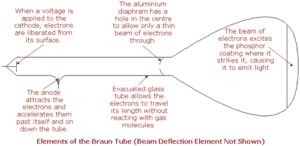The development of the first CRT was the culmination of many years, or in this case, centuries, of research and discovery which put into place all the necessary elements.
These include: the first manmade phosphor (1603); the first gas discharge tube (1751); the first production of light by exciting a phosphor with an electrical discharge (1768); and the first magnetic (1859) and electrostatic (1876) deflection of cathode-rays. Along the way, discoveries by such famous names as Bernoulli, Faraday and Hertz contributed to the sum of knowledge which allowed Karl Ferdinand Braun to combine them in what became known as the Braun tube (1897).
The Braun tube, a name still used for the CRT in Germany and in Asia, is regarded as the forerunner of the modern CRT because it was the first to contain all the essential elements of the modern product: an evacuated tube; a cathode to produce a stream of electrons; an anode to attract and accelerate the electrons; a diaphragm to restrict the size of the electron beam, providing a crude form of focusing; a magnet to deflect the beam (though only in one axis); and a phosphor lining of the faceplate to emit light. It was the use of phosphor, rather than relying on the natural phosphorescence of glass, which distinguishes the Braun tube from earlier devices such as Crookes’ tube with its familiar Maltese Cross-shaped mask.
Although the electron beam was only deflected on one axis in the first Braun tube, it was used to produce the first ocilloscope. This displayed a trace by using a rapidly rotating mirror to scan the other axis. Later, a rotating magnet, and finally a pair of magnets mounted at right angles, produced a two-dimensional trace directly on the tube’s screen.
Source: The Cathode-Ray Tube, Peter A Keller

